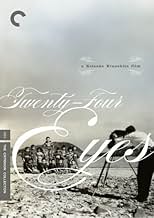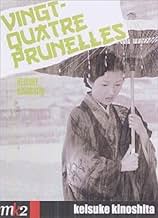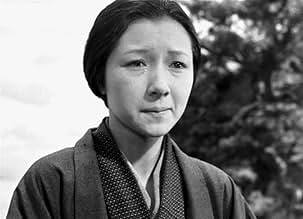NOTE IMDb
7,9/10
3,1 k
MA NOTE
L'institutrice Hisako Oishi tisse un lien affectif avec ses élèves et leur enseigne diverses vertus, tout en s'inquiétant de leur avenir.L'institutrice Hisako Oishi tisse un lien affectif avec ses élèves et leur enseigne diverses vertus, tout en s'inquiétant de leur avenir.L'institutrice Hisako Oishi tisse un lien affectif avec ses élèves et leur enseigne diverses vertus, tout en s'inquiétant de leur avenir.
- Réalisation
- Scénario
- Casting principal
- Récompenses
- 10 victoires et 1 nomination au total
Avis à la une
25 years ago I made up my mind I would move to Japan. So I wrote to people in Japan who had lived there for over thirty years, and asked them what would be the #1 movie I should watch that encapsulated the spirit of the Japanese.
They all suggested "24 Eyes".
Now, after having lived in a strictly Japanese environment for five years, and having seen well over thirty Japanese movies, not to mention over a thousand hours of TV shows and animae, it is still the #1 to me.
By today's standards it will seem extremely "G" rated, a little too slow and a bit too long. But for those who want to really understand people, and where they are coming from, I can't think of a better movie to recommend. I wish every culture, particularly those that may be going extinct, would use this movie as a guideline to tell their story.
They all suggested "24 Eyes".
Now, after having lived in a strictly Japanese environment for five years, and having seen well over thirty Japanese movies, not to mention over a thousand hours of TV shows and animae, it is still the #1 to me.
By today's standards it will seem extremely "G" rated, a little too slow and a bit too long. But for those who want to really understand people, and where they are coming from, I can't think of a better movie to recommend. I wish every culture, particularly those that may be going extinct, would use this movie as a guideline to tell their story.
"Years might go by, but the mountain colour never change."
This movie is an excellent work of art by Keisuke Kinoshita.
It starts off with a new teacher being assigned to teach the first grade in a poor village. She is initially rejected from the community, and is gossiped about constantly. However the students she teaches fall in love with her style. One of her tasks is to teach the children to sing. However, instead of teaching school songs or patriotic songs, she teaches them folk songs. Misfortune strikes and she is forced to leave the school, but not before she makes a lasting impression on the children. They will see her again, as a teacher, but not for another five years.
From these humble beginnings a rich story about the poor in Japan before, during, and after World War 2 is shown. We get to know all twelve children ("24 eyes") in the movie, and eventually learn about their fates as adults. We see the equivalent of the "Red Scare" in Japan, and the saddening events caused by World War 2. Although overdramatic, the feelings still feel genuine and even the hardest of people will not be able to resist shedding a tear or two over the fates of the children you grow to love.
I can only ask you to watch the full 3 hours. That is the only way one can truly appreciate the beauty of this film. There is nothing else to be said.
This movie is an excellent work of art by Keisuke Kinoshita.
It starts off with a new teacher being assigned to teach the first grade in a poor village. She is initially rejected from the community, and is gossiped about constantly. However the students she teaches fall in love with her style. One of her tasks is to teach the children to sing. However, instead of teaching school songs or patriotic songs, she teaches them folk songs. Misfortune strikes and she is forced to leave the school, but not before she makes a lasting impression on the children. They will see her again, as a teacher, but not for another five years.
From these humble beginnings a rich story about the poor in Japan before, during, and after World War 2 is shown. We get to know all twelve children ("24 eyes") in the movie, and eventually learn about their fates as adults. We see the equivalent of the "Red Scare" in Japan, and the saddening events caused by World War 2. Although overdramatic, the feelings still feel genuine and even the hardest of people will not be able to resist shedding a tear or two over the fates of the children you grow to love.
I can only ask you to watch the full 3 hours. That is the only way one can truly appreciate the beauty of this film. There is nothing else to be said.
Compared to a film like "Pigs And Battleships", or even "I Live In Fear"; Kinoshita's film is a middlebrow, mainstream, even sentimental take on the Japan's war years and it's aftermath.
Still, the film is graceful and touching, with what Pauline Kael called "concealed art." Kinoshita's approach seems to be to take potently maudlin situations, and film them from an objective distance; with as direct and simple emotion as possible.
This may short change the great Takamine a bit; we seem to be an hour into the film before the great actress receives a close up. Still, her performaces gains power as the film goes on.
Though politics are kept in the background, as perhaps they had to in a Japanese film of this nature; but there is an anger lurking in the backgroud; an inditement of a culture that would waste the strength of it's woman and worse; reduce it's men to cannon fodder. Was it something in Japanese life; rather than just it's military, that led to it's disasters? Even the country's great filmmakers seem hesitant to speculate. In any event, another strong film of interest to all those who have fallen under the spell of great Japanese film.
Still, the film is graceful and touching, with what Pauline Kael called "concealed art." Kinoshita's approach seems to be to take potently maudlin situations, and film them from an objective distance; with as direct and simple emotion as possible.
This may short change the great Takamine a bit; we seem to be an hour into the film before the great actress receives a close up. Still, her performaces gains power as the film goes on.
Though politics are kept in the background, as perhaps they had to in a Japanese film of this nature; but there is an anger lurking in the backgroud; an inditement of a culture that would waste the strength of it's woman and worse; reduce it's men to cannon fodder. Was it something in Japanese life; rather than just it's military, that led to it's disasters? Even the country's great filmmakers seem hesitant to speculate. In any event, another strong film of interest to all those who have fallen under the spell of great Japanese film.
Mostly unknown and frequently dismissed in the West, this film is often considered by the Japanese to be one of their very best films, if not their best. I concur with the Japanese. I can understand the issues people have with it, namely that it is overly sentimental, but I think it mostly earns the tears that are shed over it. It's a film in the classic teacher genre, like Goodbye Mr. Chips. Hideko Takamine plays Hisako Oishi, a young woman who begins the movie as a first grade teacher on a small island in 1928. Being a small population, she ends up staying with the same students for several years. The film ends in the 1950s, so you kind of know what will probably happen to her male students, and what she and her female students will have to experience. It may be somewhat predictable, but it's incredibly heartbreaking. The film is beautifully made, and filled with Japanese folk songs (strangely, the score of the film is made up of a bunch of Western music, including "Bonnie Annie Laurie" and "There's No Place Like Home"; it's definitely a flaw). Takamine, who starred in several Mikio Naruse films around the same time, is exceptional.
It was a pleasure for me to see this lovely movie, a film I've really wished to see in the last four years but I couldn't do it until today. I heard about this movie when I lived in Japan and visited Shodoshima island, where "Eiga Mura" (Cinema Village), the place this film was made, can still be visited and the atmosphere of the past can be enjoyed. To be honest, I must say that "Nijushi no hitomi" wasn't for me the "exceptional film" I expected to see, but anyway it has been a pleasant experience. The life of the rural teacher, from the start of her career (in the mid 20's) to the time she retakes her teaching position after having become a widow (in the 40's, after the end of WWII), is an interesting guide to discover the traditional life and mentalities in the small islands of Seto (Japan Inland Sea). A good point for this film: it is usually said that this is an "anti-war" film. Well, it is true that the teacher shows a clear position against the wars Japan was involved (the war against China and the later Pacific War against the USA), but this film mustn't be considered as a pacifist pamphlet: the honest position of the teacher against the war is just one more detail in this complete description of how life should be in rural Japan during those difficult prewar, war and postwar years. A film that should be shown in every school around the world.
Le saviez-vous
- AnecdotesAccording to Japanese film critic and historian Tadao Satô, in casting this film about a schoolteacher and her relationships with her pupils over many years, director Keisuke Kinoshita very cleverly chose pairs of look-alike siblings to portray the students. So for those scenes set in later years, Kinoshita simply substituted the older siblings for the younger ones, so that the schoolchildren appeared to "grow" before the audience's eyes.
- ConnexionsReferenced in L'obsédé en plein jour (1966)
- Bandes originalesAnnie Laurie
Meilleurs choix
Connectez-vous pour évaluer et suivre la liste de favoris afin de recevoir des recommandations personnalisées
- How long is Twenty-Four Eyes?Alimenté par Alexa
Détails
- Durée
- 2h 36min(156 min)
- Couleur
- Mixage
- Rapport de forme
- 1.37 : 1
Contribuer à cette page
Suggérer une modification ou ajouter du contenu manquant






















